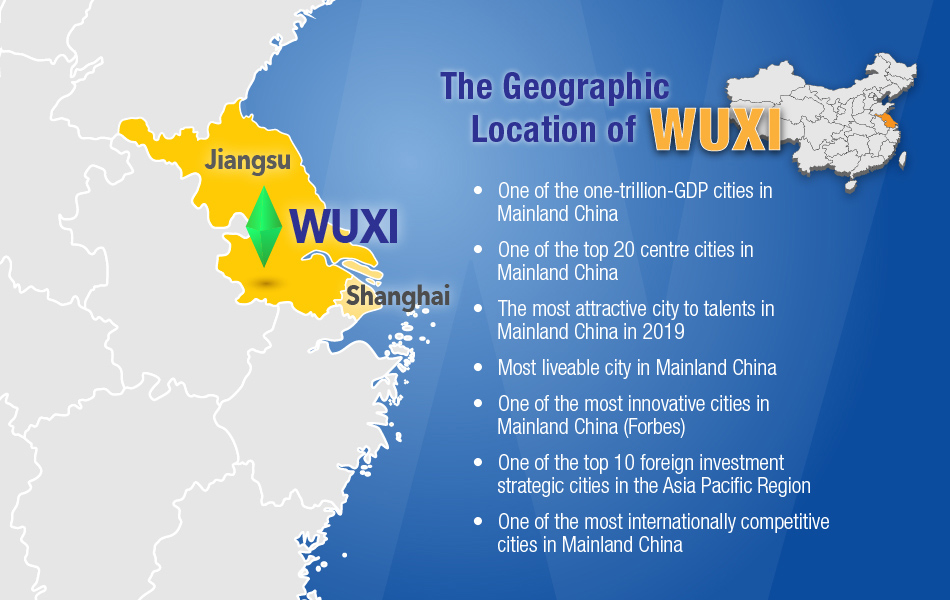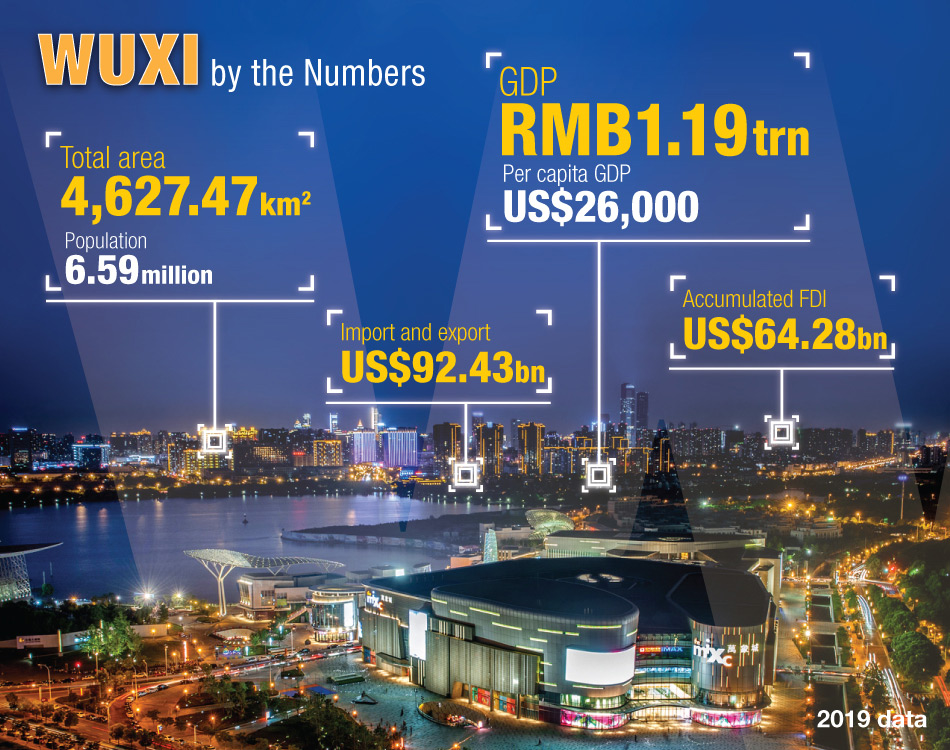With a strategic geographical location and a vibrant and innovative atmosphere, Wuxi has outperformed other places in Mainland China to become a new and energetic international hub for transport, manufacturing and service industries
Wuxi is located at the geometric centre of the Yangtze River Delta, with the Grand Canal (the Beijing−Hangzhou Grand Canal) running through the city, the Yangtze River positioned to its north and Taihu Lake to its south. Known as the Pearl of Taihu Lake, Wuxi occupies a total area of 4,627.47 square kilometres and has a permanent resident population of 6.59 million. Currently, it has jurisdiction over two county-level cities, Jiangyin and Yixing, and five municipal districts, Liangxi, Xishan, Huishan, Binhu and Xinwu, as well as the Wuxi Economic Development Zone.
Profound heritage
Wuxi is a famous city in Jiangnan with a long history and profound heritage. The city is the birthplace of the ancient Wu culture, as well as the development of industry and commerce in modern China, and the home of current township enterprises. Its magnificent scenery has nurtured numerous remarkable painters, writers, scientists and economists including Gu Kaizhi, Gu Xiancheng, Xu Xiake, Xu Beihong, Qian Zhongshu, Zhou Peiyuan, Qian Weichang and Wang Xuan, earning the city the glorious titles of “the birthplace of calligraphy and painting”, “the home of scholars”, “the cradle of economists”, and “the hometown of academics”.A prosperous economy
Wuxi is a prosperous, vibrant and innovative city. Since the implementation of the reform and opening-up policy, industry-focused township enterprises have flourished, forming the famous “Southern Jiangsu Model”. At the beginning of the 21st century, Wuxi took the lead in the province in achieving a comprehensive economy, turning itself into the seventh-most integrated competitive city in Mainland China. It is also recognised as one of the most competitive manufacturing cities and one of the best commercial cities in the country.In 2017, Wuxi’s GDP climbed to new heights, reaching trillions of dollars. In 2019, Wuxi’s GDP amounted to RMB1.19trn, ranking 13th in Mainland China. In the same year, Wuxi’s per capita GDP reached US$26,000, preceded only by Shenzhen and ranking second in the country. The city generated 1.2 per cent of Mainland China’s total economic output, an incredible achievement considering the city only occupies 0.05 per cent of the country’s total land area and 0.47 per cent of the country’s total population.

Beautiful living environment
Zhejiang is a major area for specialised markets. There are a huge number of commodity trading markets that are large in scale, strong in comprehensive capabilities and wide in reach. The province has formed a commodity trading network centred on consumer goods and production materials, supported by many other supplementary markets. In 2019, there were 3,783 commodity markets of various kinds across the province (among them, 274 are billion-dollar-level, 39 are 10-billion-dollar-level and two are 100-billion-dollar-level), and annual transaction volume reached RMB2.3trn, ranking it first in the country in terms of both number of markets and transaction value. Moreover, the province is home to Yiwu Chinese Small Commodity City, the world’s largest small commodity trading and distribution market, and Shaoxing Chinese Textile City, Asia’s largest textile trading market. It is also home to Taobao.com, Mainland China’s largest online retailer.Building a world-class advanced manufacturing base
Wuxi is a beautiful, comfortable place to live and is described as “the most gorgeous place on Taihu Lake, the flowing canal and the auspicious place of Lingshan”. It has been selected as one of the best ten travel destinations and leisure model cities in Mainland China, a top-ten ecological leisure and city and the national ecological civilisation model city. The Chinese Academy of Social Sciences and China’s Economic Daily have named it as the “most liveable city in Mainland China” for three consecutive years. With its stunning sceneries and abundant tourism resources, Wuxi has 51 national-level tourist attractions, two national-level and six provincial-level tourist resorts and one national-level and four provincial-level eco-tourism demonstration zones.Competitive and convenient
Taking advantage of its superior location, Wuxi has become a convenient transportation hub with a national, government-built integrated system. It is easily accessible by a well-weaved network of railroads, roads, sea and air. Domestically, there are eight express highways directly linking Wuxi to major cities such as Beijing, Shanghai and Guangzhou, and the Beijing−Shanghai High-speed Railway takes only 28 minutes to reach Shanghai and five hours to Beijing.Internationally, the Sunan Shuofang International Airport is a national first-class aviation point to facilitate air traffic. There are 61 direct passenger air routes to destinations such as Hong Kong, Macao, Taiwan, Japan, Singapore, Thailand, Vietnam and Cambodia, and four international freight routes to Chicago, US, Hahn, Germany, Singapore, Osaka, Japan and Incheon, Korea. In 2019, the airport recorded a throughput of 7.975 million of passengers and 145,000 tonnes of cargos. Of equal importance is the Wuxi Jiangyin Port, a national first-class port that has established connections with more than 600 ports in over 100 countries and regions around the world.

Open and far-reaching
Investors and entrepreneurs, domestic and abroad alike, see Wuxi as an open, international city, thanks to its fair, efficient and convenient global business environment. Wuxi has built good relationships with 49 cities from 28 countries around the world, and there are currently 201 enterprises in the city set up by multinational Fortune 500 companies. Wuxi has vigorously built up its advanced infrastructure and strengthening its international exposures and influences.The efforts paid off as a series of international events were held successfully in the city in the past few years, such as the 2018 World Internal Combustion Engine Conference, the 2018 World Fencing Championships, the 2019 World Internet of Things Expo and the Third China-Russia Internet Media Forum cum the 70th Anniversary of the Establishment of Diplomatic Relations between China and Russia. Other influential conferences and events held in Wuxi include the International Enterprise Resource Exchange Summit (for four consecutive years), and the China (Wuxi) International New Energy Conference (for 11 consecutive years). As of the end of 2019, Wuxi has accumulatively attracted 14,000 foreign-invested enterprises, generating an actual utilised foreign capital of US$64.28bn. In the same year, Wuxi’s trade activities spread across 213 countries and regions, with import and export values totalling US$92.43bn, US$55.46bn from exports and US$36.97bn from imports. Its top three trading partners are Korea, the US and Japan.
Wuxi’s markets are steadily diversifying, with imports from and exports to countries and regions along the Belt and Road recording a strong growth to US$22.19bn, accounting for 24 per cent of the city’s total amount of import and export values. The export values of its top nine export industries, namely electronic information, machinery equipment, textiles and apparels, chemicals, steel products, solar products, ships and vessels, wire and cable, as well as motorcycles and electric cars, are US$16.77bn, US$11.07bn, US$6.53bn, US$3.41bn, US$2.74bn, US$2.51bn, US$1.6bn, US$340m and US$260m, respectively. world.
Innovative development of strong industries
Wuxi has the only national sensor network innovation demonstration zone approved by the State Council and is the first all-optical network city in Mainland China. In 2019, the city’s total output value of the new generation of information technology industry exceeded RMB300bn. Wuxi has become a pioneer in the development of the information technology industry and a fully-fledged agglomeration in Jiangsu Province and even the whole country.Furthermore, Wuxi is also an important base for equipment manufacturing in the country. In 2019, there were 2,856 designated-size equipment manufacturing enterprises in the city, producing an output value of RMB689.59bn. The industry blossoms with a group of local enterprises such as Wuxi Lead Intelligent Equipment, Weifu High-Technology, FAW Jiefang Automotive, Wuxi Turbine Blade and Impro Precision. Numerous Fortune 500 companies including Caterpillar, Cummins, Bosch, Doosan Machinery and Kubota have set up bases in the area.
Wuxi has earnestly implemented the three-year action plan for its modern service industry with two goals: accelerate the development of different service industries such as information services, technology services, modern finance and modern logistics; and strengthen the scales for sectors such as education and training, healthcare, human resources, industrial design and cultural innovation, conventions and exhibitions, and sports.

